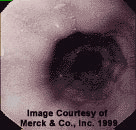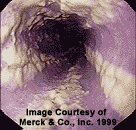Overview
Although this form of candidal mucosal infection is very similar to oropharyngeal candidiasis (OPC), we will discuss here its unique features, particularly as these relate to patients with HIV-AIDS.
Epidemiology
The risk factors for candidal esophagitis are the same as those for OPC. And, just as for OPC, candidal esophagitis has received special attention ever since the beginning of the HIV epidemic [721, 1325]. Between 3 and 10% of HIV-infected patients will first come to medical attention as the result of their first episode of candidal esophagitis [514]. The incidence of overall rate of esophagitis among patients infected with HIV has been reported to be as high as 15 to 20% [171, 172]. These rates are very much affected by use of effective anti-retroviral therapy. However, even with such therapy, patients with advanced AIDS often suffer tremendously with candidal esophagitis [1571].
Just as for OPC, Candida albicans is responsible for the vast majority of cases of symptomatic infection [239, 283]. While non-albicans Candida may be identified, patients with symptoms usually are also affected with C. albicans.
Clinical Manifestations
| Candidal esophagitis is usually, but not always, associated with simultaneous OPC [1831]. Patients with candidal esophagitis will usually have some, if not all, of the following symptoms: dysphagia (a perception of difficulty with swallowing), odynophagia (pain during swallowing), substernal chest pain that is not clearly related to swallowing, and/or a feeling of obstruction in the chest. Candidal esophagitis has been associated with fever [1537], but this is uncommon. Upon endoscopy (see photos), white exudative lesions similar to those of OPC are seen. They may be small or widely spread and contiguous.
Candidal esophagitis in patients with HIV/AIDS is sometimes said to be the “most frequent invasive candidal disease in patients with AIDS”. However, biopsy studies have shown that Candida in the esophagus is never invasive in the true sense of the word [881]. Rather the process is limited to the surface of the esophagus. Candidal esophagitis is, however, a significant disease and was the most common AIDS-defining disease in two cohorts of HIV-infected women [1537]. Candidal esophagitis usually occurs when CD4+ counts are below 100 cell/mm3 [1093], although it can also be seen during the transient immunosuppresion of acute HIV infection [443]. |
 Normal esophagus  Esophageal candidiasis |
Diagnostic Strategies
The best test for Candida esophagitis is upper gastrointestinal endoscopy. However, it has been clearly demonstrated that this expensive and invasive procedure is unnecessary in most cases. The simultaneous presence of OPC along with any of the above symptoms has a high predictive value for the diagnosis of candidal esophagitis [1831, 2431]. In this setting, a therapeutic trial of an azole is an appropriate diagnostic and therapeutic strategy. Endoscopy is reserved for patients who fail to respond to this therapeutic trial.
Blind brushing of the esophagus via nasogastric tube has been shown to have a sensitivity of 96% and a specificity of 87% [283]. Barium swallow can also show lesions that are suggestive of esophageal candidiasis, but is less sensitive (80%), even if done with a double-contrast technique (sensitivity of 88%) [1325]. However, all of these approaches are inferior to endoscopy.
Therapy
Systemically active therapy is needed for effective treatment of candidal esophagitis. The length of therapy depends on the clinical response. Ideally a course of therapy should last until 2 weeks after resolution of symptoms.
| Drug | Dosage | Comments | References |
|---|---|---|---|
| Fluconazole | 100 mg/d x 14-21 days (A loading dose of 200mg is recommended) |
Fluconazole is safe and well tolerated. It produces rapid relief and good mycological response | [171, 172, 173, 174, 1283] |
| Itraconazole solution | 100-200 mg/day x 14-21 days | Efficacy is comparable to fluconazole. The suspension should be taken on an empty stomach | [2430] |
| Itraconazole capsules | 200 mg/day x 14-21 days | Clinical response is slower than with fluconazole. It has limited bioavailability. Absorption is improved if the drug is taken with a fatty meal. | [171, 539] |
| Ketoconazole | 200-400 mg/day x 14-21 days | Less efficacious than fluconazole and itraconazole solution. It has limited bioavailability, requires an acidic environment for best absorption and causes liver toxicity. | [539, 1283] |
| Caspofungin (investigational) | 50-70 mg/day | This agent appeared quite efficacious in randomized comparisons vs. amphotericin B | [111, 1995] |
| Amphotericin B | ~0.5 mg/kg/day IV x 14-21 days | This agent is considered a second-line option, reserved for severe cases and documented failure to azoles | [196, 2429] |
Difficult Clinical Situations
The principle difficulty with candidal esophagitis is its tendency to recur in patients with advanced and uncontrolled HIV. Such relapses require either intermittent retreatment or continuous suppression. The strategies and controversies in this setting are identical to those for treatment of recurrent OPC in AIDS.
